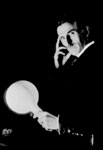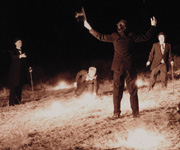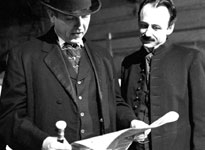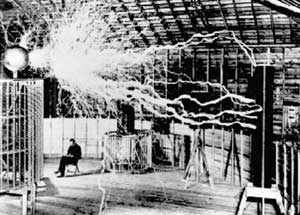TESLA IN COLORADO
Lance Accord's spectacular bio-pic Tripping the Light Electric
 |  |  |
| left to right: archival photo of Nikola Tesla; two scenes from Tripping the Light Electric. | ||
Nikola Tesla, the 19th-century Serbian-American inventor, electrified the world in more than one sense of the word; he remains a subject, almost three decades after his death, of continued fascination for both scientists, artists and quacks alike.
Tesla’s greatest discovery, the rotating magnetic field, enabled him to construct an alternating current (AC) motor and power transmission system that facilitated the distribution of electricity over great distances. With George Westinghouse’s backing, Tesla’s AC motors were installed at Niagara Falls in 1894 and began supplying electricity to Buffalo, N.Y., some 23 miles away – much to the consternation of rival Thomas Edison, who championed direct current. (DC could only travel short distances and would have required a power station every few blocks.)
Throughout the late 1880s, during the so-called War of the Currents, Edison arranged for his assistants to publicly electrocute – or "westinghouse" – cats and dogs using AC, in order to sway public opinion. N.Y. prison authorities thought the idea novel and in 1890, with Edison’s help, built the first electric chair – using AC of course. But AC soon became the world standard, making Tesla famous and Westinghouse very rich. (Tesla had unfortunately forfeited royalties from his invention in order to help Westinghouse battle Edison.)
Although he would go on to do pioneering work in flourescent lighting, radio, and radio-controlled automatons, Tesla rarely capitalized on his discoveries. Instead he dreamed of providing the world with free electricity, and with this utopian goal in mind he set out for Colorado Springs in 1899 to conduct experiments in the wireless transmission of electricity.
While measuring the effects of lighting in Colorado, Tesla discovered that the Earth itself was a perfect conductor, but he also recorded electrical signals that he could not explain and, rather unscientifically, speculated that they may have come from Mars. The tabloids had a field day.
Nevertheless, on his return to New York, he convinced J.P. Morgan to finance the construction of a huge "magnifying transmitter" on Long Island, with which Tesla hoped to electrify both land and sky (or "ether").
 |
| Archival photo of Tesla in his Colorado Springs laboratory. |
Tesla’s achievements have, more or less, guaranteed his scientific legacy. (He was credited with the invention of the radio only after his death.) But the mystery surrounding both his personal life and the uncompleted magnifying transmitter – as well as the undiminished popularity of science fiction – have inspired others as well.
David Bowie’s character in The Man Who Fell to Earth, for instance, was loosely based on Tesla, as was the laboratory in James Whale’s Frankenstein. The Unarius Academy of Science, based in El Cajon, California, reveres him as a space brother who came to Earth to raise our frequency, and both Laurie Anderson and the heavy-metal rock band Tesla have sung about him. He’s figured in the writing of Paul Auster and Dusan Makavejev, among others, and has also appeared as a secondary character in Ildikó Enyedi’s feature film, My Twentieth Century, and, more recently, in Craig Baldwin’s Spectres of the Spectrum. Over the years David Lynch, Robert Zemeckis and even Jack Nicholson have had projects in development about Tesla. But to date the only feature films realized about him are a Croatian TV mini-series and The Secret of Nikola Tesla, a 1980 U.S.-Yugoslav co-production starring Orson Welles as J. P. Morgan.
This year, to mark the 100th anniversary of Tesla’s experiments in Colorado Springs, acclaimed cinematographer Lance Acord (Buffalo 66, Being John Malkovich) has directed a 30-minute short, Tripping the Light Electric. Produced in collaboration with d.p. Jim Fealy (Splendor, The Doom Generation), editor Eric Zumbrunnen (Being John Malkovich) and screenwriter Audrius Barzdukas, the 16mm film is set to premiere at the Smokebrush Center for Arts and Theater in Colorado Springs, July 5 through 22. The film promises to be visually spectacular, featuring special effects achieved with Tesla coils, sparklers, fireworks and other handcrafted electrical devices.
More information can be culled from the film’s website, www.teslathemovie.org. — S.G.
VOD CALENDAR


 See the VOD Calendar →
See the VOD Calendar →


